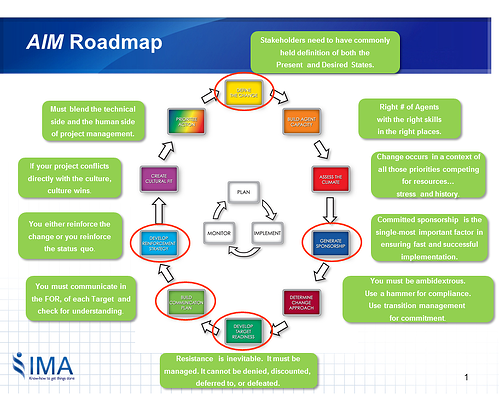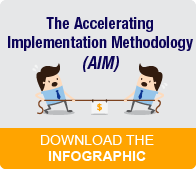When we talk to prospective clients about the AIM change management methodology, we always talk about the fact that it is a "system." Why is this important, and what are the advantages of having a system versus other change management models that are not? ![]()
One of the primary characteristics of a system is that all the elements are linked and integrated. Some of these linkages are immediately visible, but others can be more subtle.
The Visible Change Management System
What is visible, for example, is that the core elements of Defining the Change, Generating Sponsorship, Developing Readiness, Developing a Communication Plan, and Developing a Reinforcement Strategy are all linked. In the real world of change projects, the ability to do all these things to maximum benefit depends on the quality of your Sponsorship.
From the point of project initiation, the leaders not only fund and authorize the change, they must also be involved in Defining the Change. We know that a critical activity in Defining the Change is to identify the behavioral objectives. The organizational leaders must play a role and agree on what the behavioral expectations are that will change the status quo.
These changed expectations are defined in terms of new work behaviors. In healthcare transformation, for instance, physicians, nurses, support staffs, IT, and administrators all need to know personally what they will be doing differently in the future. Leaders must be involved in this translation from strategy to performance expectations.
 So there is a clear linkage between Sponsorship and the Change Definition. But these new expectations must also be communicated both at the organizational or "corporate" level, and at the individual work level. That's why we must have active Reinforcing Sponsors that are driving the change through the existing management hierarchy!
So there is a clear linkage between Sponsorship and the Change Definition. But these new expectations must also be communicated both at the organizational or "corporate" level, and at the individual work level. That's why we must have active Reinforcing Sponsors that are driving the change through the existing management hierarchy!
While we know we need to make these new expectations clear, we also know that people will only adopt new behaviors if and when they are reinforced appropriately to do things differently. So now Defining the Change, Sponsorship, Communication, and Reinforcement all are linked and integrated. None of these core elements of a change management methodology can truly be accomplished in isolation of one another!
While many Change Agents know in their gut that these activities are critical, there is no structure or framework or process for making certain the required strategies and tactics are applied for every change. It's hit and miss. That's the value of a system and a repeatable process: the elements all work together in an integrated fashion.
Behind the Curtain
Below the water line, there is more subtle integration of principles, tactics and strategies. One of the best examples is in the AIM Sponsor Assessment Tool, which is a simple but powerful measurement diagnostic that evaluates the quality of individual change leadership from a behavioral perspective.
The Tool lists the 30 most critical behaviors, with 10 each assigned to the behavioral categories of the Express, Model, and Reinforce change leadership model:
- Express: What a Sponsor says
- Model: How a Sponsor demonstrates commitment through his/her decisions, priorities, and allocation of resources
- Reinforce: How a Sponsor recognizes, rewards, penalizes, and promotes adoption of the new work expectations in observable behavior and performance
We also know from AIM principles that these three Sponsor actions are not equal, and that reinforcement is 3 times more impactful than communication. So when the Tool evaluation is totaled, the scores are weighted based on the principles. A change leader who is good at communication, but poor in reinforcement, will be seen as having greater opportunity for improvement.
It's subtle, but critical. The principles are integrated into the measurement diagnostics, so that the resulting data brings the principles to life!
Why It's Important to Your Organization
Taking a system approach is more efficient and practical. No organization has time today for activities that are unimportant. The time your Sponsors and Change Agents spend on implementation needs to be laser-focused on what will really move the dial in getting change implemented quickly. In a system, all the pieces fit together.
Efficiency, Effectiveness, and Practicality.... How does your change management methodology measure up?


